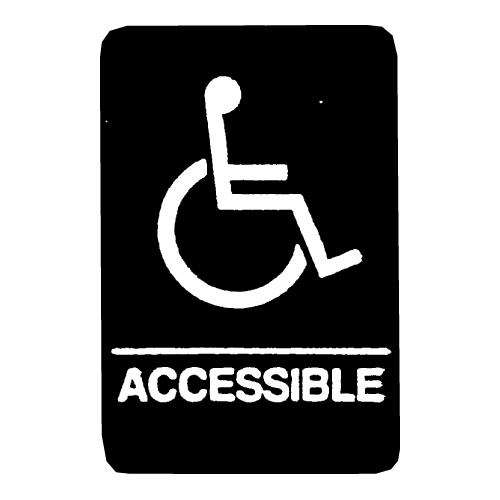Just How ADA Signs Boost Access for Everyone
Exploring the Secret Functions of ADA Indications for Improved Ease Of Access
In the world of access, ADA indications serve as silent yet effective allies, ensuring that spaces are inclusive and accessible for people with disabilities. By integrating Braille and tactile aspects, these indications damage obstacles for the visually damaged, while high-contrast color systems and readable fonts provide to varied aesthetic requirements.
Relevance of ADA Compliance
Guaranteeing compliance with the Americans with Disabilities Act (ADA) is vital for promoting inclusivity and equal gain access to in public areas and work environments. The ADA, passed in 1990, mandates that all public facilities, employers, and transport solutions suit individuals with impairments, guaranteeing they enjoy the very same rights and possibilities as others. Compliance with ADA criteria not only meets legal obligations yet additionally boosts an organization's credibility by showing its dedication to diversity and inclusivity.
One of the key facets of ADA compliance is the application of accessible signs. ADA signs are created to ensure that people with disabilities can quickly navigate with areas and structures.
Moreover, sticking to ADA policies can alleviate the threat of lawful repercussions and potential fines. Organizations that fail to abide by ADA guidelines might deal with charges or lawsuits, which can be both destructive and monetarily challenging to their public image. Thus, ADA compliance is essential to promoting an equitable atmosphere for everyone.
Braille and Tactile Aspects
The consolidation of Braille and tactile aspects right into ADA signage embodies the principles of access and inclusivity. It is commonly put below the corresponding message on signage to make sure that individuals can access the info without aesthetic assistance.
Responsive components expand past Braille and include increased personalities and symbols. These parts are designed to be noticeable by touch, permitting people to identify room numbers, toilets, departures, and various other essential locations. The ADA sets details guidelines concerning the dimension, spacing, and positioning of these tactile elements to maximize readability and make certain consistency across various settings.

High-Contrast Shade Systems
High-contrast color pattern play a crucial role in improving the visibility and readability of ADA signage for people with aesthetic impairments. These plans are essential as they maximize the distinction in light reflectance in between text and history, guaranteeing that indications are easily discernible, also from a distance. The Americans with Disabilities Act (ADA) mandates using particular shade contrasts to accommodate those with minimal vision, making it an essential facet of compliance.
The efficacy of high-contrast shades hinges on their ability to attract attention in various illumination problems, including dimly lit settings and locations with glare. Normally, dark text on a light history or light text on a dark history is utilized to achieve optimum comparison. Black message on a white or yellow history supplies a raw aesthetic distinction that aids in fast acknowledgment and comprehension.

Legible Fonts and Text Dimension
When taking into consideration the layout of ADA signage, the choice of readable font styles and ideal message dimension can not be overemphasized. The Americans with Disabilities Act (ADA) mandates that font styles should be not italic and sans-serif, oblique, script, very attractive, or of uncommon form.
According to ADA guidelines, the minimum text height should be 5/8 inch, and it should increase proportionally with seeing range. Uniformity in message dimension contributes to a cohesive aesthetic experience, aiding people in navigating settings efficiently.
Moreover, spacing in between letters and lines is indispensable to clarity. Ample spacing protects against characters from showing up crowded, enhancing readability. By sticking to these requirements, developers can substantially improve access, ensuring that signage offers its intended purpose for all individuals, no matter their aesthetic capacities.
Efficient Positioning Methods
Strategic positioning look what i found of ADA signs is important for taking full advantage of availability and making certain conformity with legal requirements. ADA standards state that indicators need to be mounted at an elevation between 48 to 60 inches from the ground to guarantee they are within the line of sight for both standing and seated people.
In addition, signs need to be put adjacent to the latch side of doors to allow very easy identification prior to entrance. This positioning aids individuals situate spaces and rooms without blockage. In instances where there is no door, indications ought to be located on the nearby surrounding wall. Uniformity in indication placement throughout a center boosts predictability, minimizing complication and improving total customer experience.

Conclusion
ADA indications play an essential duty in advertising availability by incorporating features that attend to the requirements of individuals with impairments. These aspects jointly cultivate a comprehensive environment, emphasizing the value of ADA compliance in making certain equal access for all.
In the realm of accessibility, ADA indicators serve as quiet yet powerful allies, ensuring that rooms are navigable and inclusive for individuals her latest blog with disabilities. The ADA, passed in 1990, mandates that all public centers, companies, and transport services accommodate people with disabilities, guaranteeing they enjoy the exact same civil liberties and opportunities as others. ADA Signs. ADA signs are made to make certain that people with disabilities can quickly navigate with areas and structures. ADA guidelines state that signs ought to be placed at an elevation between 48 to 60 inches from the ground to ensure they are within the line of view for both standing and seated people.ADA signs play an essential function in advertising access by incorporating attributes that deal with the demands of individuals with disabilities